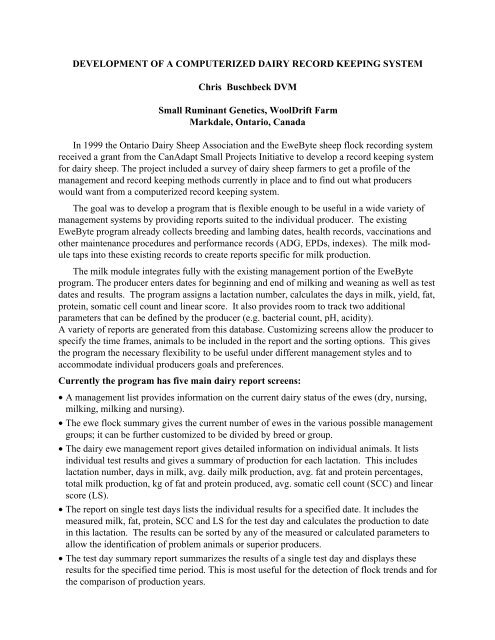Computerized dairy record keeping system.pdf
Computerized dairy record keeping system.pdf
Computerized dairy record keeping system.pdf
You also want an ePaper? Increase the reach of your titles
YUMPU automatically turns print PDFs into web optimized ePapers that Google loves.
DEVELOPMENT OF A COMPUTERIZED DAIRY RECORD KEEPING SYSTEM<br />
Chris Buschbeck DVM<br />
Small Ruminant Genetics, WoolDrift Farm<br />
Markdale, Ontario, Canada<br />
In 1999 the Ontario Dairy Sheep Association and the EweByte sheep flock <strong>record</strong>ing <strong>system</strong><br />
received a grant from the CanAdapt Small Projects Initiative to develop a <strong>record</strong> <strong>keeping</strong> <strong>system</strong><br />
for <strong>dairy</strong> sheep. The project included a survey of <strong>dairy</strong> sheep farmers to get a profile of the<br />
management and <strong>record</strong> <strong>keeping</strong> methods currently in place and to find out what producers<br />
would want from a computerized <strong>record</strong> <strong>keeping</strong> <strong>system</strong>.<br />
The goal was to develop a program that is flexible enough to be useful in a wide variety of<br />
management <strong>system</strong>s by providing reports suited to the individual producer. The existing<br />
EweByte program already collects breeding and lambing dates, health <strong>record</strong>s, vaccinations and<br />
other maintenance procedures and performance <strong>record</strong>s (ADG, EPDs, indexes). The milk module<br />
taps into these existing <strong>record</strong>s to create reports specific for milk production.<br />
The milk module integrates fully with the existing management portion of the EweByte<br />
program. The producer enters dates for beginning and end of milking and weaning as well as test<br />
dates and results. The program assigns a lactation number, calculates the days in milk, yield, fat,<br />
protein, somatic cell count and linear score. It also provides room to track two additional<br />
parameters that can be defined by the producer (e.g. bacterial count, pH, acidity).<br />
A variety of reports are generated from this database. Customizing screens allow the producer to<br />
specify the time frames, animals to be included in the report and the sorting options. This gives<br />
the program the necessary flexibility to be useful under different management styles and to<br />
accommodate individual producers goals and preferences.<br />
Currently the program has five main <strong>dairy</strong> report screens:<br />
• A management list provides information on the current <strong>dairy</strong> status of the ewes (dry, nursing,<br />
milking, milking and nursing).<br />
• The ewe flock summary gives the current number of ewes in the various possible management<br />
groups; it can be further customized to be divided by breed or group.<br />
• The <strong>dairy</strong> ewe management report gives detailed information on individual animals. It lists<br />
individual test results and gives a summary of production for each lactation. This includes<br />
lactation number, days in milk, avg. daily milk production, avg. fat and protein percentages,<br />
total milk production, kg of fat and protein produced, avg. somatic cell count (SCC) and linear<br />
score (LS).<br />
• The report on single test days lists the individual results for a specified date. It includes the<br />
measured milk, fat, protein, SCC and LS for the test day and calculates the production to date<br />
in this lactation. The results can be sorted by any of the measured or calculated parameters to<br />
allow the identification of problem animals or superior producers.<br />
• The test day summary report summarizes the results of a single test day and displays these<br />
results for the specified time period. This is most useful for the detection of flock trends and for<br />
the comparison of production years.
A summary report for individual animals is still under construction, but will be added in the<br />
near future. This report will allow comparisons between lactations and years for specified groups<br />
of animals or the entire flock.<br />
The program is currently tested by a number of participating <strong>dairy</strong> producers and will be<br />
released with the next version of EweByte.
















